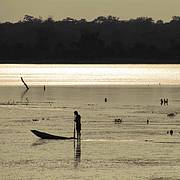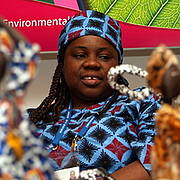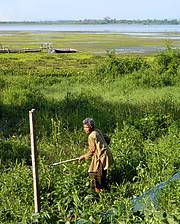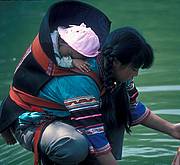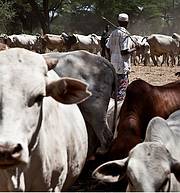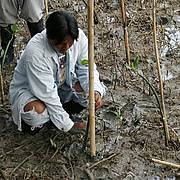The nature equation
02 August 2012 | Article
Nature+ is the theme of the 2012 IUCN World Conservation Congress. Enrique Lahmann and Célia Zwahlen explain its significance.
Why did we decide to put a ‘plus’ with the word Nature? Is nature in itself not compelling enough?
If you look at it – Nature+ – you can see that it is like the beginning of a mathematical equation. But it is an unfinished equation; something must come after to make it complete.
Nature+ is like the constant of a physics formula. It is a given, a force we cannot do without, like gravity, mass or light.
The heart of all things
You can break down and peel off any aspect of the societies we have developed, any aspect of human existence, layer after layer: you will always find Nature at the most basic level. It is the heart of all things.
Nature is the fundamental factor of our world. In fact, it IS our world. Without nature, this would not be Earth and we would not be human. Actually, we would not be at all. Because nature is synonymous with life.
In the last century, humans have started to search the stars to look for signs of life elsewhere. What will it take to realise how precious our world is? How many million light years must we search through to appreciate the fact that we are exceptionally lucky? Life is all around us. Open your eyes and you will see it.
A vital link
So to come back to the initial question: Why did we put a ‘plus’ with the word Nature? Well, it is to remind ourselves that Nature is the vital component of every aspect of our lives, from the economies we have developed to the food we put in our children’s mouths. Everything we do, everything we try to achieve is intrinsically attached to Nature.
This is a bond we cannot break, like the laws of physics.
Nature conservation is central when it comes to valuing that bond. At IUCN, we have always said that all actors of society need to be engaged in conservation, because Nature concerns all of us, without exception.
With seven billion people on the planet, now more than ever it is a priority to conserve and value the environment. It is our collective responsibility: we owe it to future generations and to the well-being of people today and for many more years to come.
Short-sighted
If our models of economic and social development continue to focus on increasing production and consumption, without taking into account the impact this has on the environment, then development can only be short lived. It is unsustainable to ignore the consequences our actions have on biodiversity or climate change.
To see the immediate benefits, without thinking about what it will cost in the future, is short-sighted and potentially very destructive. This is like jumping off a plane without a parachute. Initially you will feel euphoric, a sense of freedom, like floating in the air. But eventually, gravity draws you closer to the ground and when you realise you are falling, it is too late.
This is a law of physics: if you jump, you fall. If you don’t take a parachute, your fall will be fatal.
The danger is similar if we keep ignoring our unbreakable bond with Nature for the sake of short-term gains.
Solutions for the long term must take Nature into the equation. For societies around the world to flourish and give rise to good living conditions, they must focus on developing in a sustainable way.
The solutions
Nature conservation does not hamper human well-being or economic development. Quite the contrary. Our work in IUCN is centred on nature-based solutions.
Over time, the overall costs and risks of climate change will be equivalent to losing up to 20% of global GDP each year, while the costs of action now can be limited to around 1% of global GDP each year.
Forests, wetlands and coral reefs help to protect us and our sources of income from natural disasters and climate change. Healthy coastal ecosystems, for example, are effective in reducing small to medium-sized floods. Mangroves not only reduce coastal floods but also home nursery habitat for fish and other marine life, which are critical for food and income sources.
Wetlands and peatlands provide storage space for flood waters. In Sri Lanka, an important marsh covering over 3,000 hectares acts as a buffer and regulates flood water by releasing it into the sea. This service from nature is estimated at more than US$ 5 million in much higher avoided damage costs.
With healthy ecosystems, nature can provide the infrastructure that we need to be more resilient.
This is real action on the ground with concrete solutions and long-term results.
Lessons from the field
The stories reported back from hands-on conservation work are a rich source of information. At the World Conservation Congress, we harness their potential to determine the best course of action for sustainable development.
When we identify an issue that needs attention, we do it by looking at the science. Across the world, thousands of scientific volunteers lend their expertise to IUCN and gather the latest information on the state of the environment.
These field projects, pulled together from different regions of the world, feed a pool of knowledge. The experiences of people at the front line of conservation provide us with extremely valuable information.
Such resources are fundamental to identify effectively where our attention is most needed. The lessons learnt from the implementation of projects are brought to the higher policy level.
The structure of IUCN makes that dialogue possible. It creates a cycle of feedback from the global to the regional level and back to the global arena. It ensures there is a connection between field work and policy decisions. This is a powerful dynamism, empowered by the Congress.
A reality check
The immense advantage of having one foot on the ground and the other in policy debate is that it allows for a reality check. Policy recommendations go beyond theoretical confines and the resolutions that are decided on are focused on bringing solutions.
This is why the Congress is IUCN’s highest and most important decision-making body. Members come together to engage in a democratic process – the Members’ Assembly – and together they take joint decisions and influence the global conservation agenda for the next four years.
People from the four corners of the world and from all walks of life in the same place join for the Congress. From global policy-makers in the private and public sectors to members of small-scale NGOs, regional communities and academia: they discuss together the future of nature conservation.
The Forum, which is the public platform of debate at the World Conservation Congress, connects people who would otherwise never meet.
They exchange with each other very different experiences and observations; they can compare and contrast the lessons they have learnt. Sharing knowledge is a strong learning experience.
Such a mix of people with wide-ranging conservation interests and varying levels of influence helps to develop concrete and practical solutions.
People are the true agent of nature conservation. This is why the IUCN Congress, which provides hands-on training, showcases new concepts and presents success stories on nature-based solutions, is important. These are all learning experiences that people can take back home and spread to their communities.
This strength makes the IUCN Congress unique and ensures the advances of the conservation debate internationally are anchored in reality.
Change takes time but time is scarce when threats to biodiversity are so imminent. The challenge today is to overcome the slow uptake of concrete action and provide the knowledge and instruments to work with, not against, nature.
IUCN’s World Conservation Congress is vital to activate positive change and generate tangible results. It is crucial to restore equilibrium into the Nature+ equation.
Enrique Lahmann is Congress Director and Célia Zwahlen is Congress Communications Officer.
